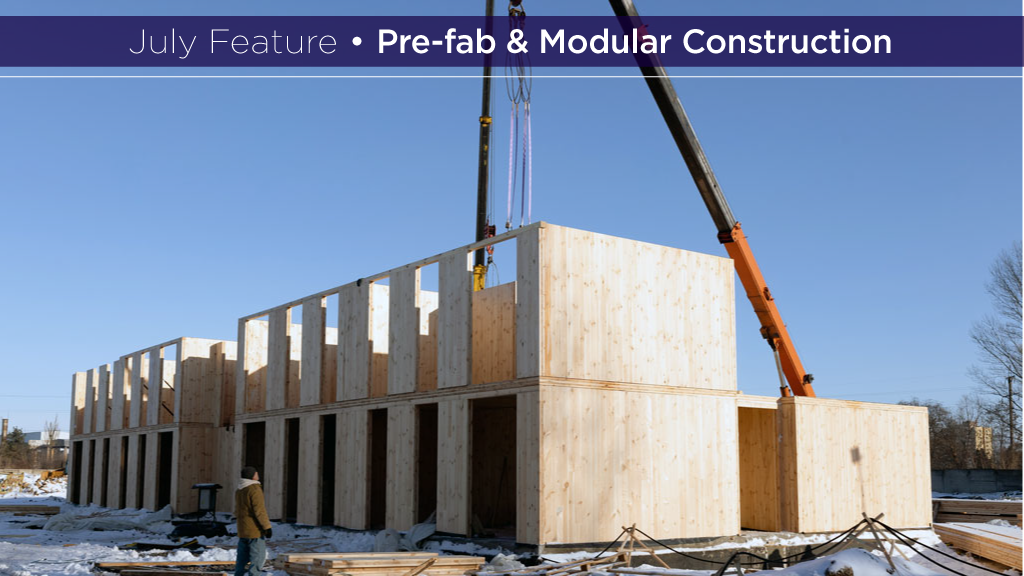Prefabricated construction has been touted as what we need to build the millions of new homes Canada requires and, at the same time, solve the country’s skilled labour shortage.
Many small- and medium-sized construction companies are interested in prefab and would like to find out more about it.
Although onsite building is tried-and-true in North America, it is quite rare in Europe, said Guido Wimmers, dean of the School of Construction and Environment at British Columbia Institute of Technology.
“Onsite construction is too expensive for Europe,” said Wimmers. “Prefab uses less energy and labour, which makes prefab very attractive for Europeans.”
There are two kinds of prefab construction, said Wimmers.
A modular building is made of one or more prefabricated modules that are grouped and/or stacked to form larger structures.
“The modules can be small, such as a bathroom, or large, such as an entire building,” he said.
Panelized construction involves producing individual building components offsite.
Panels are transported to the construction site, where they are assembled to create a final structure.
“If time is of the essence and you’re building the same types of rooms repetitively, for a school or a hotel, for example, then modular is the way to go,” said Wimmers. “Modular wins on speed. But if you have more time, panelization is more efficient and will save money.”
In B.C., the “sweet spot” for transitioning from building offsite to prefab is between grades three and four of the BC Energy Step Code, which sets performance requirements for new construction and groups them into steps.
“At four or after, offsite prefab becomes more efficient,” said Wimmers.
Companies contemplating getting into prefab construction should be at least of medium size.
“The overhead needed to do prefab is high,” said Wimmers. “To do it economically, you need to produce at least one single-family house per week or about 10 multi-family buildings per year.”
A company with between 10 and 20 employees is not big enough, said Wimmers.
“It needs to have between 40 and 60 employees,” he said.
Helen Goodland, head of research and innovation at Scius Advisory, a Vancouver consulting firm, studied architecture in the U.K.
She said Canadian builders should look at Europe for a big-picture view of prefab construction.
“North America has an emerging prefab industry, but it’s still way behind Europe’s,” said Goodland.
“Prefab is more economic and efficient in Europe than here because North America has a lot more geography than Europe,” she said. “It’s spread out more. Because European travel distances are shorter, their manufacturers of prefab components have access to bigger markets than North American manufacturers.”
Because of their geographical advantages, European prefab factories are larger and more automated.
“Europe has a full spectrum of prefabricated components, so the construction industry in Europe has more choice.” said Goodland. “But the situation here is changing. Governments are mandated to deliver more housing and prefab construction can deliver more housing faster.”
Some Canadian construction companies have caught the prefab bug and are doing some innovative things with it.
Naikoon Contracting Ltd. in North Vancouver uses mass-timber panels built offsite to construct a variety of housing, commercial and mixed-use construction.
President Joe Geluch said Naikoon has pioneered an innovation he calls the flying factory.
“The flying factory is a prefab manufacturing facility on wheels that can be moved by truck and a small crane to different worksites as they’re needed,” said Geluch. “It occupies about one acre.”
Naikoon has been using the flying factory for about five years.
“We’ve also built flying factories that can produce panels for five B.C. First Nations,” said Geluch.
Chris Hill, president of BCollective Houses Inc. in North Vancouver, said his company is “unlocking the potential of prefab.”
Hill said the company’s motto is “FF and A – Forming, Framing and Airtight.”
The small company specializes in making structural load-bearing walls that are built off-site at its 6,500-square-foot factory near downtown Vancouver.
“We provide a service to builders in the Vancouver area,” said Hill. “We’re the only company of its kind in the region that we’re aware of.”
Prefab is, in fact, not as new as some people think it is.
Vancouver developer and retired architect Michael Geller said he began thinking about modular housing more than 50 years ago after a tour of early prefab housing in the U.S.
He also discovered , a U.S. government innovative housing demonstration project
And even before Operation Breakthrough, U.S. builders like Levitt and Sons were using the principles of mass-production learned during the Second World War to build naval facilities to produce, quickly and inexpensively, millions of housing units for returning war veterans.



Recent Comments
comments for this post are closed